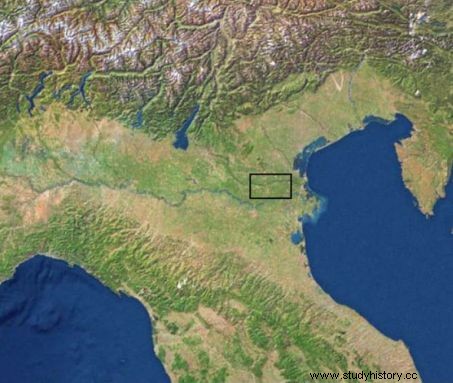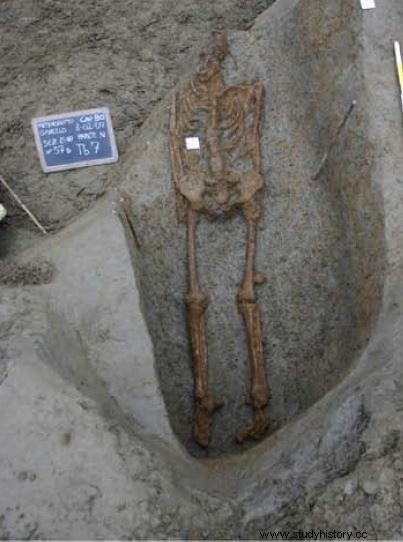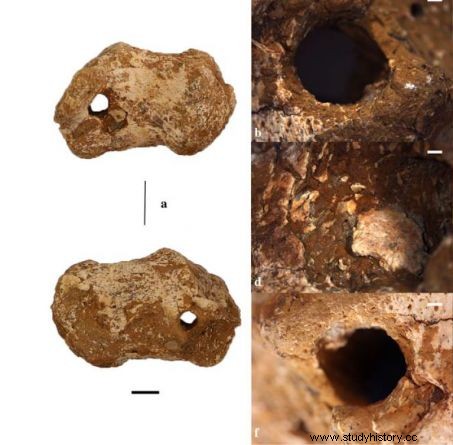A 2,000-year-old skeleton discovered in Italy may be the second ever documented case of crucifixion.

Punishment by crucifixion was applied by Rome for over 500 years.
Have the remains of a crucified man been discovered in Italy? This is the opinion of a team of researchers from the universities of Ferrara and Florence who have just published in the journal Archaeological and Anthropological Sciences the results of various anthropological analyzes carried out on a body of about thirty years old - nicknamed the man of Gavello - exhumed 12 years ago in Veneto, in the north of Italy. "Despite the poor state of preservation of the skeleton, we were able to demonstrate that these human remains showed damage related to this type of execution" , declared Emanuela Gualdi-Russo, professor specializing in Anatomy at the University of Ferrara, to the Estense newspaper. Unearthed in 2007 in an isolated tomb in Larda di Gavello, near Rovigo in the Po Valley, experts see in a singular lesion identified on the foot of the skeleton the trace of this punishment.
Skeleton of the crucified man from Gavello, at the time of its discovery in 2007. © Soprintendenza archeologia per le provincia di Verona, Rovigo e Vicenza

Region of Rovigo, in the Po plain, where the remains of the man from Gavello were unearthed. © Soprintendenza archeologia per le provincia di Verona, Rovigo e Vicenza
Particularly cruel, crucifixion (or crucifixion), an infamous capital punishment, was frequently applied in Roman Antiquity from the 3 e century BCE to 337 CE, until Emperor Constantine 1 st (272-337) prohibits the practice of this summum supplicium , as defined by Roman criminal law. Surprisingly, apart from the most famous of cases - that of Jesus of Nazareth -, or those of the 6,000 rebellious gladiators and slaves led by Spartacus in 71 BC, all crucified along the via Appia -> from Rome to Capua - only one proven direct proof has come down to us! In a tomb dated 1 st century AD discovered at Giv'at ha-Mivtar, northeast of Jerusalem (1968), were indeed the remains of a man in his twenties by the name of Yehohanan ben Hagkol:the bone of his heel was still crossed by an iron stake of 11.5cm, proof that he had indeed been nailed to a cross.

Calcaneum pierced with its iron nail, of the crucified of Giva'at ha-Mivtar, (1st century). © Israel Museum, Jerusalem
The new analysis conducted by Italian academics on the bones found at Rovigo could therefore be a milestone. According to the signatories of the publication, "the right heel - the only one preserved -, unequivocally shows an entry hole [of the nail] and a crossing lesion to the external face of the foot ".
(a) Right calcaneus of Gavelo's man, showing the impact of the nail, as it enters and exits. © 3D images Hirox University of Siena
During this very painful and slow execution, nails were driven into the condemned man's wrists or forearms to fix them to the crossbar of a wooden cross (patibulum ), as well as in the feet, together or separately. The spikes were planted either in the heel bones (at the level of the calcaneus) or through the metatarsals, in the middle of the foot. The cross was then erected on the side of a road or an elevation, in full view of all. The crucified would die from exhaustion and in excruciating pain, at the end of a progressive asphyxiation linked to his position. To add to the ordeal that could last several days, his legs were sometimes deliberately broken below the knees (crucifragium ). Once dead, the body was often left on the cross to be devoured by predators. Cicero considered it the most cruel and terrifying punishment.
Therefore, how to explain that of the countless victims of this torture, such rare cases have come down to us? A few assumptions were made. As the victims of crucifixion were generally "criminals", deserting soldiers, slaves or parricides, their remains were thrown into rivers, in ditches or given to dogs and scavengers as food. The nails could also have been recovered because of the magical properties attributed to them and preciously preserved as amulets. However, without the presence of these spikes, it is difficult for specialists to identify the stigmata of the punishment due to the deterioration of the bone remains.
About the crucifixion
Punishment born in the Assyrian, Babylonian and Persian worlds, the Romans who would have learned it from the Carthaginians applied it for more than 500 years. Flavius Josephus (37-100), in his account of the Jewish War , recounts that around 80 BC, during the reign of Alexander Janneus, King of Judea and High Priest of Israel (103 – 76 BC), 800 opponents were put to death by crucifixion.


